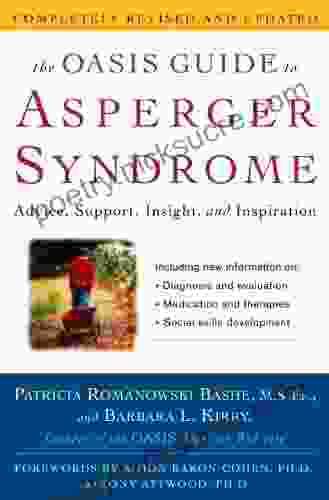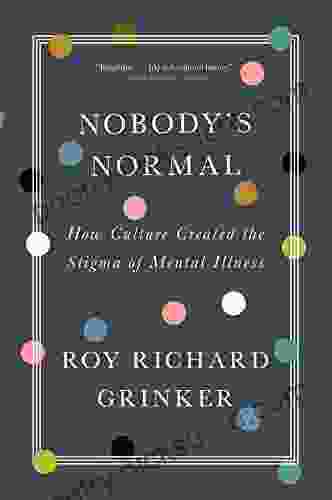How Culture Fabricates the Stigma of Mental Illness: A Tapestry of Historical, Anthropological, and Societal Perspectives

: Unraveling the Stigma's Threads
Mental illness has long carried an unwarranted burden of stigma, casting a shadow of shame and exclusion upon those affected. The origins of this stigma lie deep within the tapestry of human culture, woven into its historical, anthropological, and societal fabric. This article embarks on an exploratory journey, delving into the cultural forces that have shaped this stigma, examining its historical roots, cross-cultural variations, and the profound impact it continues to have on individuals and society.
Chapter 1: Historical Roots: The Evolution of Shame and Fear
In the annals of history, the treatment of mental illness has fluctuated between compassion and condemnation. In ancient Greece and Rome, mental disorders were often seen as divine punishment or possession by evil spirits. Those afflicted were subjected to rituals of purification or, in extreme cases, execution.
4.7 out of 5
| Language | : | English |
| File size | : | 1159 KB |
| Text-to-Speech | : | Enabled |
| Screen Reader | : | Supported |
| Enhanced typesetting | : | Enabled |
| X-Ray | : | Enabled |
| Word Wise | : | Enabled |
| Print length | : | 435 pages |
As Christianity spread across Europe, mental illness became increasingly associated with sin and moral failing. The rise of asylums in the 17th century saw the confinement of the mentally ill in often inhumane conditions, further stigmatizing their condition.
The 19th century brought a shift towards medicalizing mental illness, but the stigma persisted. Psychiatric diagnoses became a means of social control, labeling individuals as "mad" or "insane" and excluding them from society.
Chapter 2: Anthropological Perspectives: Cultural Variations in Stigma
The stigma of mental illness is not universal; it varies significantly across cultures. Anthropological research reveals that the way societies view and respond to mental illness is shaped by their beliefs, values, and social norms.
In some cultures, mental illness is seen as a temporary state of possession or imbalance, while in others it is viewed as a permanent condition that necessitates social isolation. Cultural factors such as the role of the family, community support networks, and beliefs about mental health can all influence the level of stigma associated with mental illness.
Chapter 3: Societal Biases: Discrimination and Exclusion
The stigma of mental illness extends beyond its cultural roots, deeply ingrained in societal biases and prejudices. Individuals with mental health conditions face discrimination in various aspects of their lives, including employment, housing, and education.
Societal stereotypes often portray individuals with mental illness as violent or unpredictable, fueling fear and mistrust. These biases lead to exclusion and discrimination, exacerbating the social isolation and marginalization faced by those affected.
The media also plays a significant role in perpetuating the stigma, often sensationalizing stories about mental illness and reinforcing negative stereotypes.
Chapter 4: The Impact on Individuals and Society
The stigma of mental illness has profound consequences for both individuals and society as a whole. For individuals, stigma can lead to feelings of shame, isolation, and a diminished sense of self-worth.
It can also discourage individuals from seeking help for mental health concerns, resulting in delayed diagnosis, inadequate treatment, and a perpetuation of the illness. Moreover, stigma contributes to the cycle of poverty and homelessness among people with mental illness.
For society, the stigma of mental illness creates a barrier to accessing effective mental healthcare, perpetuating the burden of untreated illness and the associated societal costs.
Chapter 5: Addressing the Stigma: A Collective Endeavor
Tackling the stigma of mental illness requires a multi-faceted approach involving individuals, communities, and society at large. Here are some key strategies:
- Education and Awareness: Raising awareness about mental health conditions, their symptoms, and effective treatments can help dispel myths and misconceptions.
- Language Matters: Using respectful and non-stigmatizing language is crucial. Terminology such as "person with mental illness" emphasizes the individual's humanity rather than their illness.
- Media Responsibility: The media plays a significant role in shaping public perceptions. Responsible reporting and the portrayal of individuals with mental illness as complex and multifaceted characters can challenge stereotypes.
- Anti-Discrimination Laws: Laws prohibiting discrimination based on mental health status help protect individuals from bias in employment, housing, and other areas.
- Peer Support and Community Outreach: Peer support groups and community outreach programs provide a sense of belonging and reduce isolation for individuals with mental illness. They also contribute to advocacy and the reduction of stigma.
: Towards a More Understanding and Inclusive Society
The stigma of mental illness is a cultural artifact that has persisted for centuries. However, through a deeper understanding of its historical, anthropological, and societal roots, we can work to dismantle this stigma and create a more inclusive and supportive society.
By challenging biases, promoting awareness, and implementing effective strategies, we can empower individuals with mental illness to live full and meaningful lives. The journey towards a stigma-free society requires collective effort and compassion, recognizing that mental health is an integral part of overall well-being and a fundamental human right.
4.7 out of 5
| Language | : | English |
| File size | : | 1159 KB |
| Text-to-Speech | : | Enabled |
| Screen Reader | : | Supported |
| Enhanced typesetting | : | Enabled |
| X-Ray | : | Enabled |
| Word Wise | : | Enabled |
| Print length | : | 435 pages |
Do you want to contribute by writing guest posts on this blog?
Please contact us and send us a resume of previous articles that you have written.
 Fiction
Fiction Non Fiction
Non Fiction Romance
Romance Mystery
Mystery Thriller
Thriller SciFi
SciFi Fantasy
Fantasy Horror
Horror Biography
Biography Selfhelp
Selfhelp Business
Business History
History Classics
Classics Poetry
Poetry Childrens
Childrens Young Adult
Young Adult Educational
Educational Cooking
Cooking Travel
Travel Lifestyle
Lifestyle Spirituality
Spirituality Health
Health Fitness
Fitness Technology
Technology Science
Science Arts
Arts Crafts
Crafts DIY
DIY Gardening
Gardening Petcare
Petcare Philip Gibson
Philip Gibson Jean Barbre
Jean Barbre Scott Shupe
Scott Shupe Bob Cary
Bob Cary Sparknotes
Sparknotes Lori L Tharps
Lori L Tharps Peyton Curley
Peyton Curley Mike Reilly
Mike Reilly J Scott Long
J Scott Long Mishka Shubaly
Mishka Shubaly Annalyn Ng
Annalyn Ng Skeleton Steve
Skeleton Steve Morton Manus
Morton Manus Stefan Hollos
Stefan Hollos Ben Shneiderman
Ben Shneiderman Susan M Schneider
Susan M Schneider Randall Fitzgerald
Randall Fitzgerald Anna Watson
Anna Watson Gwen Mckee
Gwen Mckee Sheela Raja
Sheela Raja Jay Spence
Jay Spence Peter Richmond
Peter Richmond Aaron Mahnke
Aaron Mahnke Kristian Berg
Kristian Berg Angela Saini
Angela Saini Boye Lafayette De Mente
Boye Lafayette De Mente Kalman Samuels
Kalman Samuels Zach Hunter
Zach Hunter Gill James
Gill James Geryn Childress
Geryn Childress L A Cotton
L A Cotton Jemar Tisby
Jemar Tisby Anna Crowley Redding
Anna Crowley Redding Roy M Wallack
Roy M Wallack Maya Van Wagenen
Maya Van Wagenen G Norman Lippert
G Norman Lippert M Terese Verklan
M Terese Verklan Josephine Mccarthy
Josephine Mccarthy Prime Hall
Prime Hall Vladimir Vasiliev
Vladimir Vasiliev Margaret Jean Langstaff
Margaret Jean Langstaff Walter Mischel
Walter Mischel Susan Spicer
Susan Spicer Julie Plagens
Julie Plagens Christelle Dabos
Christelle Dabos Michael Hodgson
Michael Hodgson Annette Burns
Annette Burns Tanmay Mehta
Tanmay Mehta Jessa Stone
Jessa Stone P M Gilbert
P M Gilbert Asker Jeukendrup
Asker Jeukendrup Curtis Collins
Curtis Collins Lisa Manterfield
Lisa Manterfield Steve Grant
Steve Grant Graham Robb
Graham Robb Dr Sarita Uhr
Dr Sarita Uhr Richard Appleton
Richard Appleton Steven G Krantz
Steven G Krantz Valerie Hansen
Valerie Hansen Naomi Tomky
Naomi Tomky Miley Smiley
Miley Smiley H Jerome Chapman
H Jerome Chapman Joey Myers
Joey Myers James Burke
James Burke Frances Schultz
Frances Schultz Robert Gerver
Robert Gerver John Gignilliat
John Gignilliat Sean Purchase
Sean Purchase Jill Lepore
Jill Lepore Christopher T Coughlin
Christopher T Coughlin Chic Scott
Chic Scott William Goldman
William Goldman Barb Musick
Barb Musick Horace Freeland Judson
Horace Freeland Judson Stephanie Cave
Stephanie Cave Ichigo Takano
Ichigo Takano Michael G Manning
Michael G Manning Christine Hopfgarten
Christine Hopfgarten Caryl Phillips
Caryl Phillips Ann Voskamp
Ann Voskamp Daniel Isberner
Daniel Isberner Seth Stephens Davidowitz
Seth Stephens Davidowitz Harley Mcallister
Harley Mcallister Danny Jones
Danny Jones Julie C Meloni
Julie C Meloni Michael Labossiere
Michael Labossiere Craig Ramsay
Craig Ramsay Dan Koboldt
Dan Koboldt John Murray
John Murray Suzanne Clark
Suzanne Clark Caroline Miller
Caroline Miller Bert Mendelson
Bert Mendelson Finn Aagaard
Finn Aagaard Linda K Miller
Linda K Miller Margaret Paul
Margaret Paul Sally Connolly
Sally Connolly Martin N Seif
Martin N Seif Jonathan Pd Buckley
Jonathan Pd Buckley Chris Bailey
Chris Bailey Michael F Nenes
Michael F Nenes Breeda Bermingham
Breeda Bermingham Rebecca A Moyes
Rebecca A Moyes Krista Marson
Krista Marson Emmett W Hines
Emmett W Hines John Van Wyhe
John Van Wyhe Elizabeth Wissner Gross
Elizabeth Wissner Gross Ralph Waldo Emerson
Ralph Waldo Emerson Richard A Swanson
Richard A Swanson Randy J Paterson
Randy J Paterson Charles J Sanders
Charles J Sanders Justine Gregory Williams
Justine Gregory Williams R A Salvatore
R A Salvatore Sandy Camillo
Sandy Camillo Lexi Ryan
Lexi Ryan Kendall Coyne
Kendall Coyne Livia Bitton Jackson
Livia Bitton Jackson Kristen L Mauk
Kristen L Mauk Nelson Dellis
Nelson Dellis Richard C Schwartz
Richard C Schwartz C W Farnsworth
C W Farnsworth James P Sethna
James P Sethna Zoe Moore
Zoe Moore Annabel Streets
Annabel Streets Malcolm S Thaler
Malcolm S Thaler Dorothy Ours
Dorothy Ours Gemma Bray
Gemma Bray Julian Of Norwich
Julian Of Norwich Chris Gore
Chris Gore Todd Radom
Todd Radom Hanumant Deshmukh
Hanumant Deshmukh Christopher Seddon
Christopher Seddon Anna Quindlen
Anna Quindlen Bernard Stiegler
Bernard Stiegler Sally Annjanece Stevens
Sally Annjanece Stevens Todd Denault
Todd Denault Tarani Chandola
Tarani Chandola Gary Chapman
Gary Chapman Roy R Grinker
Roy R Grinker June Hur
June Hur Patrick Torsell
Patrick Torsell H M Schey
H M Schey John Pullen
John Pullen James F Twyman
James F Twyman Adele Faber
Adele Faber Thomas A Garrity
Thomas A Garrity John O Sullivan
John O Sullivan Ann Marie Brown
Ann Marie Brown Peter Wacht
Peter Wacht Barry Schwartz
Barry Schwartz Les Livingstone
Les Livingstone Adil E Shamoo
Adil E Shamoo Barry Dainton
Barry Dainton Eddie Jones
Eddie Jones Helen Adrienne
Helen Adrienne Chase Hassen
Chase Hassen Darryl Belfry
Darryl Belfry Jonathan R Brennan
Jonathan R Brennan Shelley Emling
Shelley Emling Nicholas Clapp
Nicholas Clapp Larry Semento
Larry Semento Jenn Bennett
Jenn Bennett Hope Comerford
Hope Comerford Joshua Shifrin
Joshua Shifrin Jenna Evans Welch
Jenna Evans Welch Chronicle Books
Chronicle Books Scott Allan
Scott Allan Kass Morgan
Kass Morgan Alexander L Chapman
Alexander L Chapman Geoff Greig
Geoff Greig Rick Page
Rick Page Heidi Kreider
Heidi Kreider Marie Cirano
Marie Cirano Steve Bowkett
Steve Bowkett Becky Wade
Becky Wade Mary E Pearson
Mary E Pearson Zena Hitz
Zena Hitz Mark Matlock
Mark Matlock James C Zimring
James C Zimring C J Brown
C J Brown Brian Daccord
Brian Daccord Robert A Conover
Robert A Conover Oskar Morgenstern
Oskar Morgenstern Marjorie Savage
Marjorie Savage Michael Tan
Michael Tan Linda Lewis Alexander
Linda Lewis Alexander Mark Mckinney
Mark Mckinney Laurie Varga
Laurie Varga Damian Hall
Damian Hall Dana James
Dana James Reinhard Kleist
Reinhard Kleist Michael Burnett
Michael Burnett Donna D Ignatavicius
Donna D Ignatavicius Ray Moynihan
Ray Moynihan Julie A Ross
Julie A Ross Pawel Malczewski
Pawel Malczewski Judy Corry
Judy Corry Holly Chism
Holly Chism Paul Bloom
Paul Bloom Ellen Dugan
Ellen Dugan Jackie Bolen
Jackie Bolen James C Scott
James C Scott Katharine Beals
Katharine Beals Illysa R Foster
Illysa R Foster Tim Young
Tim Young Tyler Richards
Tyler Richards Mordecai Orimiladeye
Mordecai Orimiladeye David Woods
David Woods Sam Demas
Sam Demas George Lakoff
George Lakoff Joe Hyams
Joe Hyams Peter Watson
Peter Watson Melvin Fitting
Melvin Fitting John Yates
John Yates Anna Lowenhaupt Tsing
Anna Lowenhaupt Tsing Annaka Harris
Annaka Harris Jennifer Dugan
Jennifer Dugan Helge Kragh
Helge Kragh Timothy P Schultz
Timothy P Schultz Good Books
Good Books Vittal S Anantatmula
Vittal S Anantatmula Scott P Sells
Scott P Sells Anna Ivey
Anna Ivey L Chapman
L Chapman Gilbert J Grant Md
Gilbert J Grant Md Trevor Hartman
Trevor Hartman Wayne C Booth
Wayne C Booth Ann Mccallum Staats
Ann Mccallum Staats Steve Oldenburg
Steve Oldenburg Antonio Robert
Antonio Robert Dave Whitlock
Dave Whitlock Crystal Cook
Crystal Cook Genevieve Mckay
Genevieve Mckay Kathy Morey
Kathy Morey Dave Hall
Dave Hall Bren Smith
Bren Smith Fox Fisher
Fox Fisher Cade Courtley
Cade Courtley Darcie Little Badger
Darcie Little Badger Melanie Dickerson
Melanie Dickerson Julian Havil
Julian Havil Illustrated Edition Kindle Edition
Illustrated Edition Kindle Edition Jay Allan
Jay Allan Tim Cahill
Tim Cahill Timothy Ellis
Timothy Ellis Buddy Lee
Buddy Lee Dave Canterbury
Dave Canterbury Neel Doshi
Neel Doshi David Soucie
David Soucie Creative Guy
Creative Guy Cathy Glass
Cathy Glass Fumio Sasaki
Fumio Sasaki Christina Henry De Tessan
Christina Henry De Tessan Anna Flores Locke
Anna Flores Locke Sandy Bodeau
Sandy Bodeau Matthew Rudy
Matthew Rudy Stephen J Pyne
Stephen J Pyne Ellen Painter Dollar
Ellen Painter Dollar Ian Moulding
Ian Moulding John Baichtal
John Baichtal Ariel Dalfen
Ariel Dalfen Tara Haelle
Tara Haelle Zach Davis
Zach Davis Joanna Wells
Joanna Wells Eric Greitens
Eric Greitens Lizzie Collingham
Lizzie Collingham Nicholas Thomas
Nicholas Thomas Emily J Taylor
Emily J Taylor Hill Harper
Hill Harper Stephen Tarsitano
Stephen Tarsitano Steve Schwartz
Steve Schwartz The Pinnacle Review
The Pinnacle Review Junior Health Institute
Junior Health Institute Paul Mendelson
Paul Mendelson Kate Mcvaugh
Kate Mcvaugh Jason
Jason Howard Means
Howard Means Will Kurt
Will Kurt Paulo Guillobel
Paulo Guillobel Paul Logothetis
Paul Logothetis R K Agarwal
R K Agarwal College Hippo
College Hippo Anne Sylvie Malbrancke
Anne Sylvie Malbrancke Richard A Ruth
Richard A Ruth Clive Scarff
Clive Scarff Larry Thornberry
Larry Thornberry Lisa Randall
Lisa Randall Jacqueline Winslow
Jacqueline Winslow Christine Field
Christine Field Neal Shusterman
Neal Shusterman Glen E Clarke
Glen E Clarke Sharon Rowley
Sharon Rowley Ralph Cockburn
Ralph Cockburn Martin Meredith
Martin Meredith Jennifer Kostick
Jennifer Kostick Philip Reed
Philip Reed Harnarayan Singh
Harnarayan Singh Jacob Ward
Jacob Ward Dr Harper
Dr Harper Tali Sharot
Tali Sharot Bob Madgic
Bob Madgic Rick Sparkman
Rick Sparkman Arcturus Publishing
Arcturus Publishing Rebecca Carroll
Rebecca Carroll Chris Fregly
Chris Fregly L J Smith
L J Smith David Berry
David Berry Stan Gibilisco
Stan Gibilisco Harold Davis
Harold Davis Kristina Cowan
Kristina Cowan Anna Della Subin
Anna Della Subin Guy Windsor
Guy Windsor Ken Robinson
Ken Robinson Holly Bourne
Holly Bourne Sean Covey
Sean Covey J E Esslemont
J E Esslemont Daphne Poltz
Daphne Poltz Worley Faver
Worley Faver M Shawn Copeland
M Shawn Copeland Earl Hipp
Earl Hipp Kennedy Achille
Kennedy Achille Jennifer L Lopez
Jennifer L Lopez Dan Gardner
Dan Gardner Richard Mcafee
Richard Mcafee John Edwards
John Edwards John Dickson
John Dickson Shannon Vallor
Shannon Vallor Eleanor J Sullivan
Eleanor J Sullivan Charles Dickens
Charles Dickens Robert A Cook
Robert A Cook Sharman Apt Russell
Sharman Apt Russell Silvia M Lindtner
Silvia M Lindtner Carl Mckeating
Carl Mckeating Pierluigi Barrotta
Pierluigi Barrotta Bethany Saltman
Bethany Saltman Janine Marsh
Janine Marsh Ray Eye
Ray Eye Robert F Boszhardt
Robert F Boszhardt Bella Forrest
Bella Forrest Suzanne Girard Eberle
Suzanne Girard Eberle Stacey Williams
Stacey Williams Bob Labbe
Bob Labbe Joyce Meyer
Joyce Meyer Cb Droege
Cb Droege Rutger Bregman
Rutger Bregman Helen E Lees
Helen E Lees Louise Katz
Louise Katz Peter Hathaway Capstick
Peter Hathaway Capstick Jack Perconte
Jack Perconte Mikael Lindnord
Mikael Lindnord Patricia Romanowski Bashe
Patricia Romanowski Bashe Noel D Justice
Noel D Justice Matthew Cobb
Matthew Cobb Isaac Fitzsimons
Isaac Fitzsimons Nisha Garg
Nisha Garg Anna Grafl
Anna Grafl Patricia Ladis
Patricia Ladis Freddy Silva
Freddy Silva Suzanne I Barchers
Suzanne I Barchers Anna B Doe
Anna B Doe Sara Wickham
Sara Wickham Sally Black
Sally Black Ann Zaprazny
Ann Zaprazny Sarah Stodola
Sarah Stodola Omari Bouknight
Omari Bouknight Alex Bromley
Alex Bromley Stefanie Japel
Stefanie Japel Stacey A Shannon
Stacey A Shannon Mike Roberts
Mike Roberts Kyung Won Chung
Kyung Won Chung Ruby Mcconnell
Ruby Mcconnell Karen Bassie Sweet
Karen Bassie Sweet Margaret Rogerson
Margaret Rogerson Winton Porter
Winton Porter W W Sawyer
W W Sawyer Melissa Mortenson
Melissa Mortenson Robby Weber
Robby Weber Sajni Patel
Sajni Patel Susan G Solomon
Susan G Solomon Frank Thomas
Frank Thomas Wendy Leo Smith
Wendy Leo Smith Henry Dillon
Henry Dillon Robin Esrock
Robin Esrock Marva Boatman
Marva Boatman George James Grinnell
George James Grinnell Lina Beard
Lina Beard Luke Schumacher
Luke Schumacher Barak A Bassman
Barak A Bassman Bruce Lockwood
Bruce Lockwood Ford R Bryan
Ford R Bryan Steven Yellin
Steven Yellin Susan Straub
Susan Straub Johnny Chuong
Johnny Chuong Julie Creffield
Julie Creffield Anna Bright
Anna Bright Claire Walter
Claire Walter Lily Siou
Lily Siou Ann Valett
Ann Valett Anna Wood
Anna Wood Dean Buonomano
Dean Buonomano Horace Kephart
Horace Kephart Dan Vogel
Dan Vogel Sara Dyer
Sara Dyer Shawn Shallow
Shawn Shallow Katie Krimer Ma Lcsw
Katie Krimer Ma Lcsw Steve Bennett
Steve Bennett Roger Hall
Roger Hall Jenny Jacobs
Jenny Jacobs L J Martin
L J Martin Steven A Fino
Steven A Fino Steven Munatones
Steven Munatones Barbara Sealock
Barbara Sealock Steven Callahan
Steven Callahan Victor Stringer
Victor Stringer Michael Witwer
Michael Witwer E R Truitt
E R Truitt Nancy Marie White
Nancy Marie White Dave Hughes
Dave Hughes Steve Newell
Steve Newell Jonathan Franklin
Jonathan Franklin Zach Codings
Zach Codings Gloria Chadwick
Gloria Chadwick Sherry B Ortner
Sherry B Ortner John Dunn
John Dunn Peter L Falkingham
Peter L Falkingham Stuart Tomlinson
Stuart Tomlinson Julia Galef
Julia Galef Charlene Beswick
Charlene Beswick Jackson Carter
Jackson Carter Ling Seto
Ling Seto Jeff Kuehl
Jeff Kuehl Steve Olson
Steve Olson Quinn Loftis
Quinn Loftis Joy Dawson
Joy Dawson Sean Bartram
Sean Bartram Pradeepa Narayanaswamy
Pradeepa Narayanaswamy Monroe Wildrose
Monroe Wildrose Lily Dunn
Lily Dunn Matthew Locricchio
Matthew Locricchio Dannah Gresh
Dannah Gresh Sukhveer Singh
Sukhveer Singh Jay Young
Jay Young Douglas Perry
Douglas Perry Dante Fortson
Dante Fortson Louis Van Dyke
Louis Van Dyke Elisabeth Haich
Elisabeth Haich Hannah Testa
Hannah Testa Maggie Downs
Maggie Downs William P Young
William P Young Lane Demas
Lane Demas Tony Osgood
Tony Osgood
Light bulbAdvertise smarter! Our strategic ad space ensures maximum exposure. Reserve your spot today!

 Jules VerneHarley Merlin 20: Persie Merlin and the Witch Hunters - A Thrilling Adventure...
Jules VerneHarley Merlin 20: Persie Merlin and the Witch Hunters - A Thrilling Adventure...
 Calvin FisherThe Ultimate Psychological and Emotional Guide to Thru-Hiking the Pacific...
Calvin FisherThe Ultimate Psychological and Emotional Guide to Thru-Hiking the Pacific...
 Dashawn HayesIgnite Your Instagram Presence with Comprehensive Guides: A Comprehensive...
Dashawn HayesIgnite Your Instagram Presence with Comprehensive Guides: A Comprehensive... Rodney ParkerFollow ·10.3k
Rodney ParkerFollow ·10.3k John SteinbeckFollow ·10.7k
John SteinbeckFollow ·10.7k Victor HugoFollow ·3.5k
Victor HugoFollow ·3.5k Isaac MitchellFollow ·19.3k
Isaac MitchellFollow ·19.3k Ignacio HayesFollow ·17.4k
Ignacio HayesFollow ·17.4k John MiltonFollow ·11.7k
John MiltonFollow ·11.7k Junichiro TanizakiFollow ·17.4k
Junichiro TanizakiFollow ·17.4k John ParkerFollow ·16.2k
John ParkerFollow ·16.2k

 Aldous Huxley
Aldous HuxleyMorgenstern: A Classic Tale of True Love and High...
Morgenstern is a...

 Beau Carter
Beau CarterThe Oasis Guide to Asperger Syndrome
What is Asperger Syndrome? Asperger...

 Chadwick Powell
Chadwick PowellFinding Your Way Through Loss Grief: A Therapist S Guide...
Grief is a natural human emotion that we...
4.7 out of 5
| Language | : | English |
| File size | : | 1159 KB |
| Text-to-Speech | : | Enabled |
| Screen Reader | : | Supported |
| Enhanced typesetting | : | Enabled |
| X-Ray | : | Enabled |
| Word Wise | : | Enabled |
| Print length | : | 435 pages |












